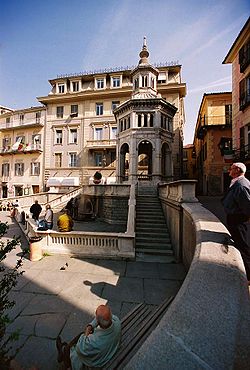Acqui Terme
|
Acqui Terme Äich |
||
|---|---|---|
| Comune | ||
| Comune di Acqui Terme | ||

La Bollente spring.
|
||
|
||
| Location of Acqui Terme in Italy | ||
| Coordinates: 44°41′N 08°28′E / 44.683°N 8.467°ECoordinates: 44°41′N 08°28′E / 44.683°N 8.467°E | ||
| Country | Italy | |
| Region | Piedmont | |
| Province / Metropolitan city | Alessandria (AL) | |
| Frazioni | Lussito, Ovrano, Moirano | |
| Government | ||
| • Mayor | Enrico Bertero (PdL) | |
| Area | ||
| • Total | 33.42 km2 (12.90 sq mi) | |
| Elevation | 156 m (512 ft) | |
| Population (30 September 2008) | ||
| • Total | 20,488 | |
| • Density | 610/km2 (1,600/sq mi) | |
| Demonym(s) | Acquesi | |
| Time zone | CET (UTC+1) | |
| • Summer (DST) | CEST (UTC+2) | |
| Postal code | 15011 | |
| Dialing code | 0144 | |
| Patron saint | Guido of Acqui | |
| Saint day | June 11 | |
| Website | Official website | |
Acqui Terme (Piedmontese: Äich) is a city and comune of Piedmont, northern Italy, in the province of Alessandria. It is about 35 kilometres (22 mi) south-southwest of Alessandria. It is one of the principal winemaking communes of the Italian DOCG wine Brachetto d'Acqui.
The hot sulphur springs have been famous since this was the Roman town of Aquae Statiellae; the ancient baths are referred to by Paulus Diaconus and the chronicler Liutprand of Cremona. In 1870 Giovanni Ceruti designed a little pavilion, known as La Bollente, for the spot at the centre of the town where the waters bubble up at 75 °C (167 °F).
In the Roman period the place was connected by road with Alba Pompeia and Augusta Taurinorum (Turin). The local Ligurian tribe of the Statielli had joined the Romans at an early period, but were attacked in 173 BCE and some were transferred to the north of the Po. In the neighbourhood of the town, near the river Bormida, are the remains of the aqueduct which supplied it.
In the 6th century it became part of the Lombard kingdom of northern Italy. Acqui was ruled by its bishop from 978, becoming an independent commune in 1135. In 1278 it was annexed to the Marquisate of Montferrat, to which it belonged until the acquisition by the Duchy of Savoy.
It was connected by a railway line to Genoa in 1892.
...
Wikipedia


